Abstract
1. The sensory neuropeptide substance P (SP), when released from sensory nerves, has been implicated in the development of neurogenic inflammation. In the present study, using an in vivo model system, we have characterized and investigated the mechanisms underlying SP-induced leukocyte accumulation and oedema formation in the guinea-pig. 2. Intradermally injected SP (i.d., 10(-13) - 10(-9) mol per site), induced a dose- and time-dependent accumulation of 111In-neutrophils, 111In-eosinophils and oedema formation as measured by the local accumulation of i.v. injected 125I-albumin. The leukocyte accumulation evoked by SP was significant at 10(-10) and 10(-9) mol per site, whereas oedema formation was significant at the lowest dose tested (10(-13) mol per site). 3. The NK1 receptor antagonists, CP-96,345 (1 mg kg-1, i.v.) and RP-67,580 (10 micrograms per site, i.d.), significantly attenuated the oedema formation induced by the lower doses of SP. Oedema formation and leukocyte accumulation induced by 10(-9) mol per site SP were unaffected by either antagonist. 4. SP-elicited responses were not significantly affected by the platelet activating factor (PAF) receptor antagonist, UK-74,505 (2.5 mg kg-1, i.v.) or the H1 histamine receptor antagonist, chlorpheniramine (10(-8) mol per site, i.d.). However, the 111In-eosinophil accumulation, but not the 111In-neutrophil accumulation or oedema formation, induced by SP was significantly inhibited by the specific 5-lipoxygenase (5-LO) inhibitor, ZM-230,487 (10(-8) mol per site, i.d.).(ABSTRACT TRUNCATED AT 250 WORDS)
Full text
PDF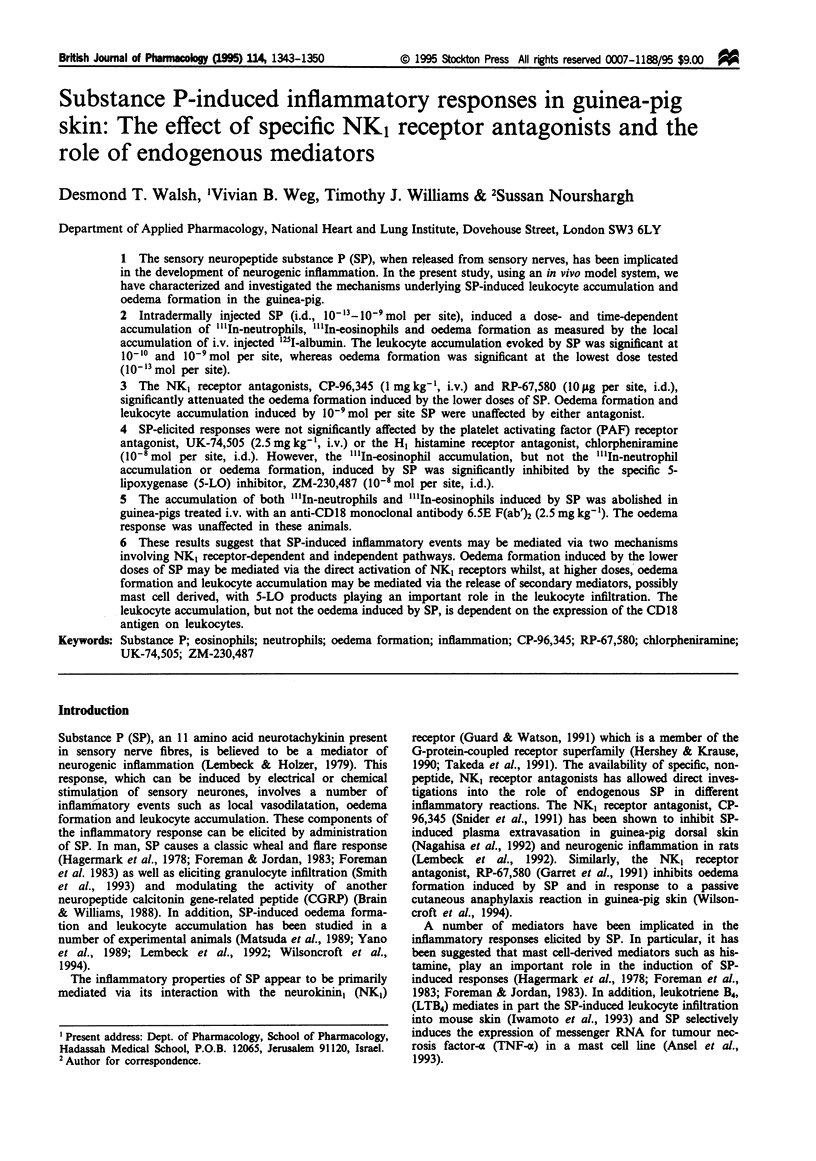
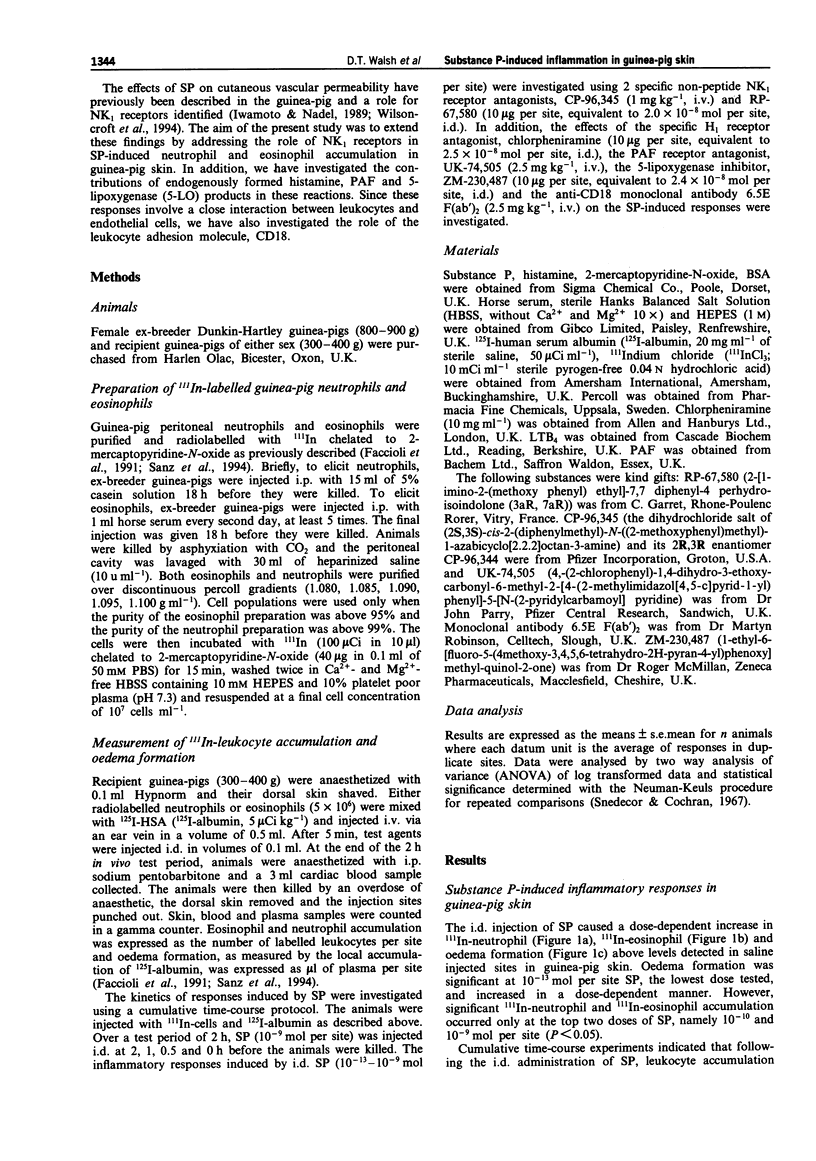
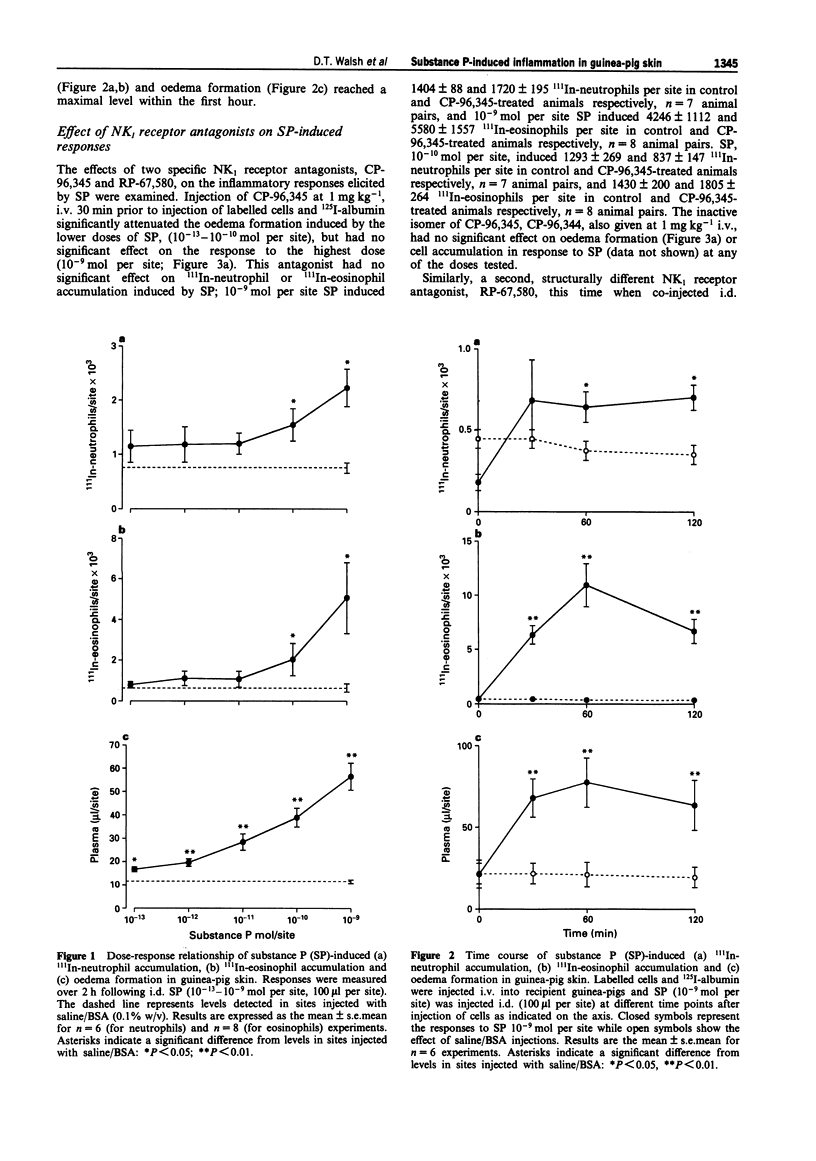
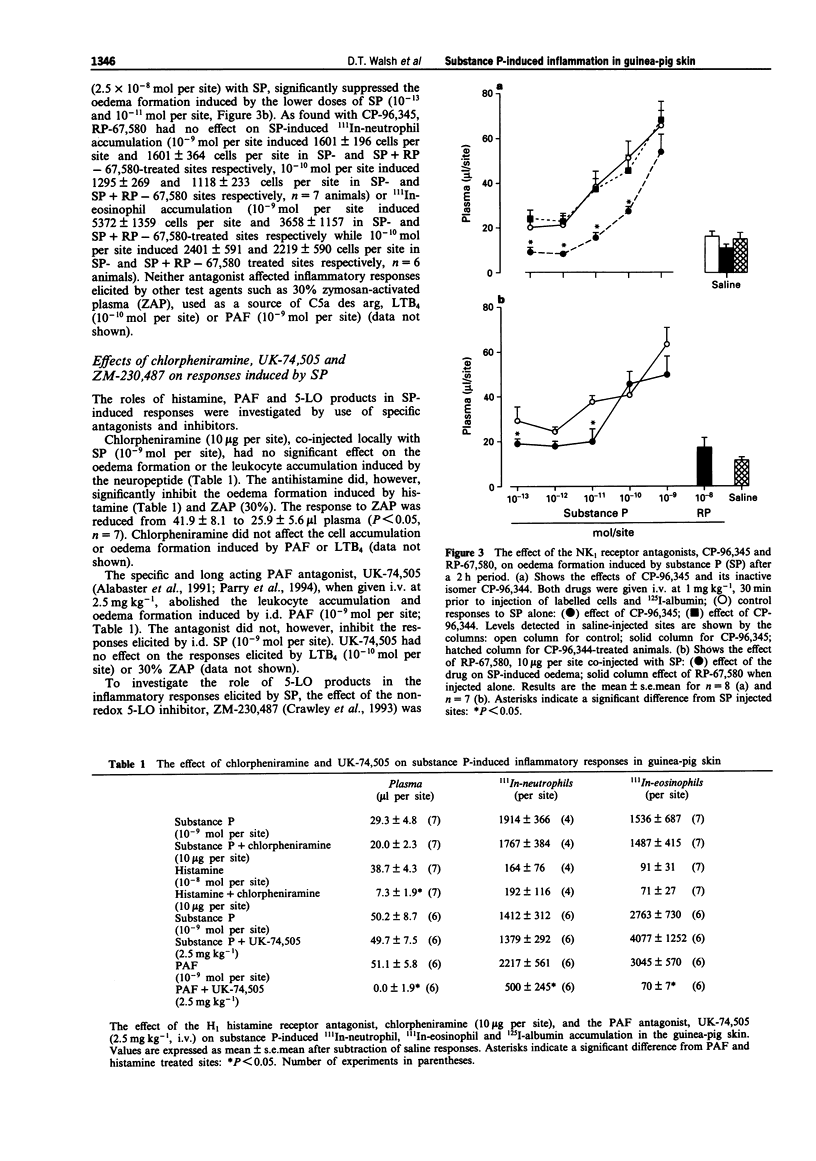
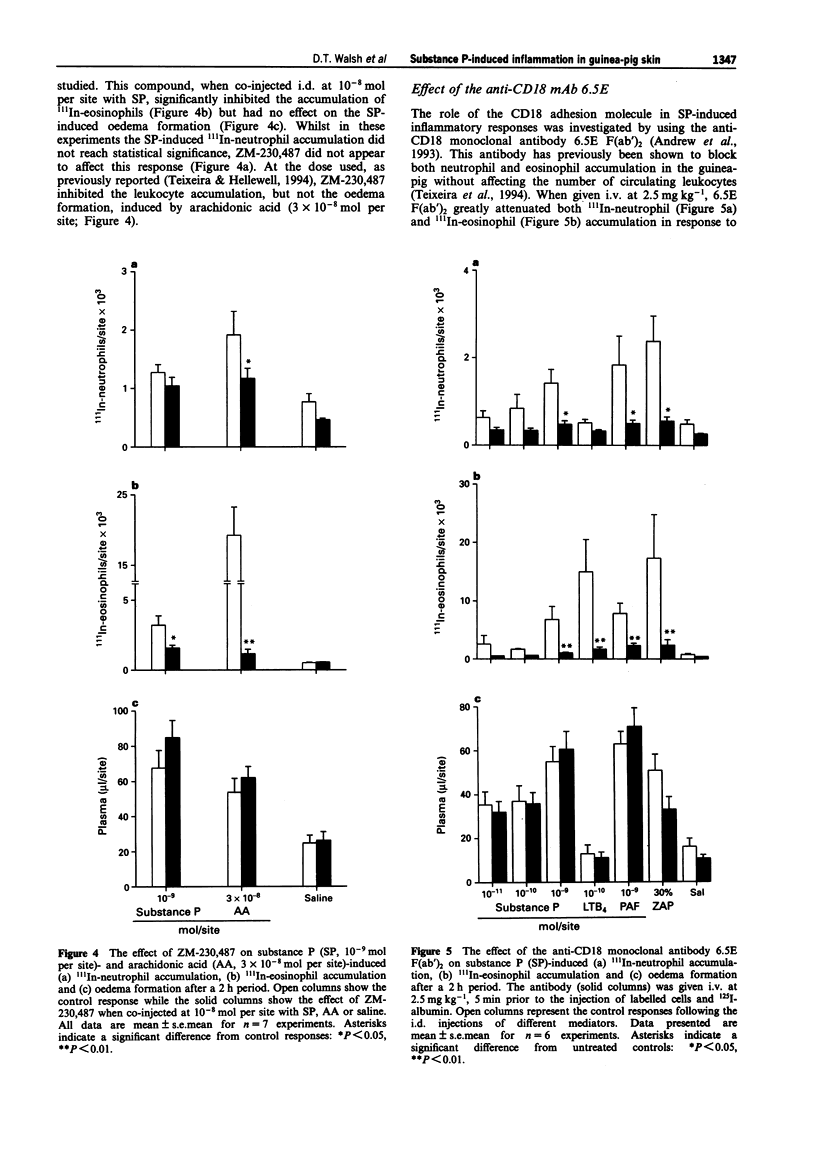
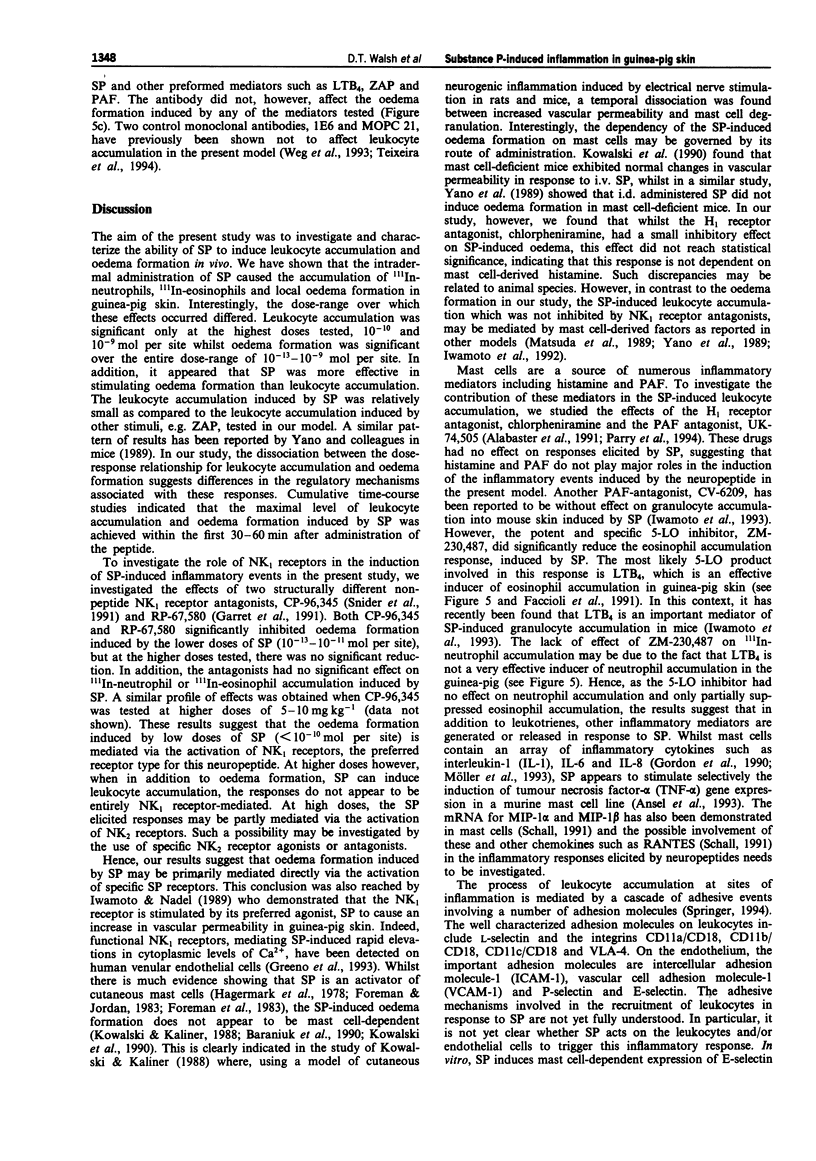
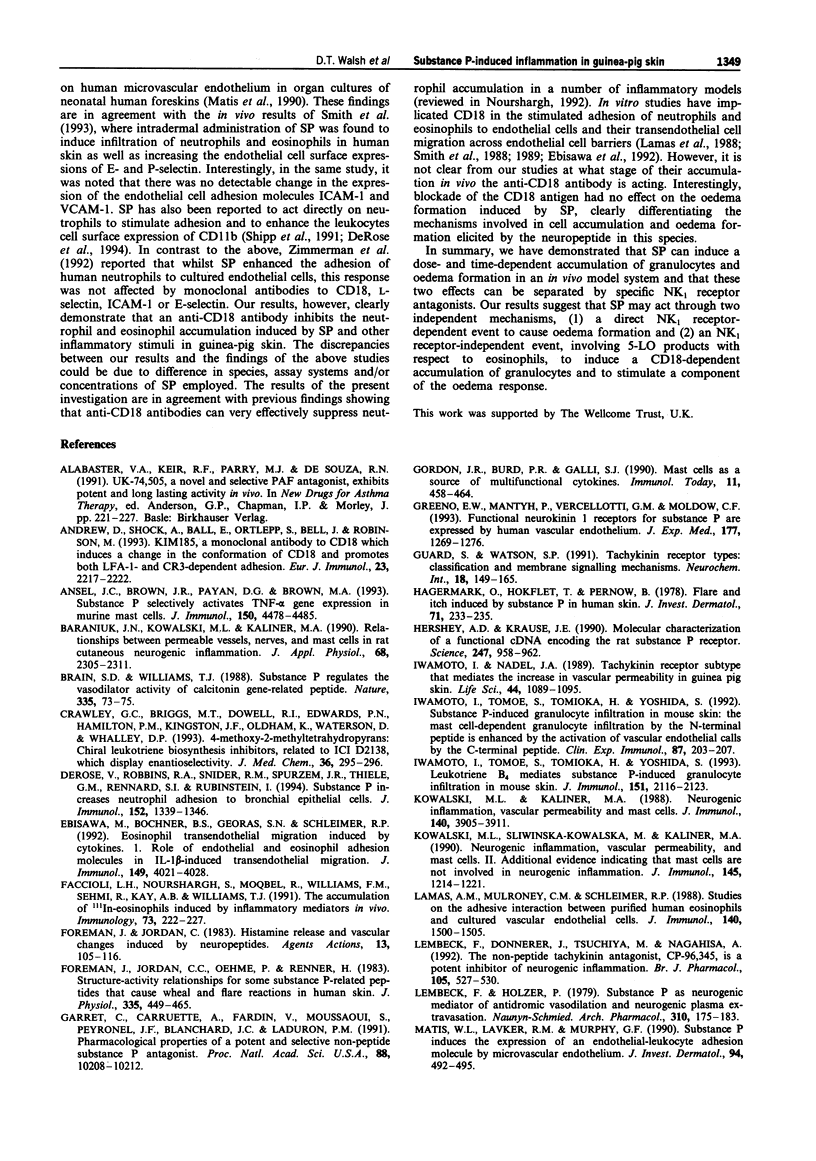
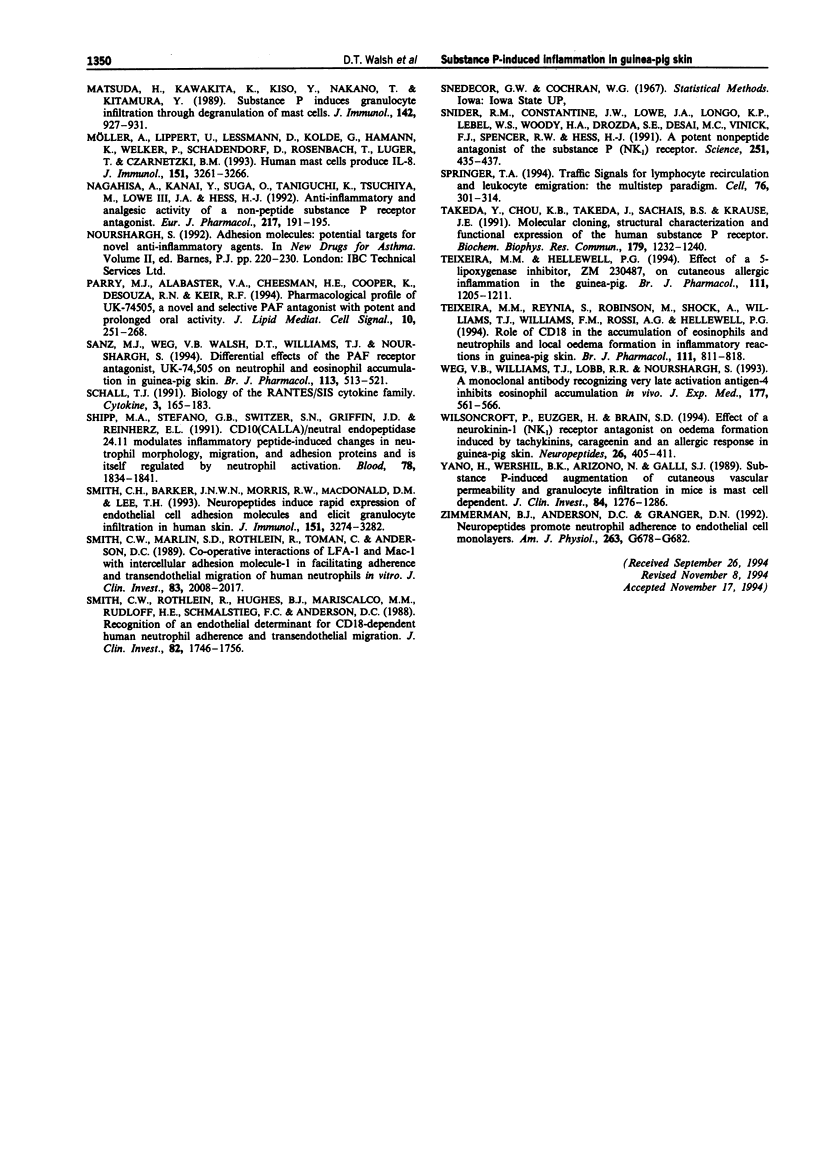
Selected References
These references are in PubMed. This may not be the complete list of references from this article.
- Alabaster V. A., Keir R. F., Parry M. J., de Souza R. N. UK-74,505, a novel and selective PAF antagonist, exhibits potent and long lasting activity in vivo. Agents Actions Suppl. 1991;34:221–227. [PubMed] [Google Scholar]
- Andrew D., Shock A., Ball E., Ortlepp S., Bell J., Robinson M. KIM185, a monoclonal antibody to CD18 which induces a change in the conformation of CD18 and promotes both LFA-1- and CR3-dependent adhesion. Eur J Immunol. 1993 Sep;23(9):2217–2222. doi: 10.1002/eji.1830230925. [DOI] [PubMed] [Google Scholar]
- Ansel J. C., Brown J. R., Payan D. G., Brown M. A. Substance P selectively activates TNF-alpha gene expression in murine mast cells. J Immunol. 1993 May 15;150(10):4478–4485. [PubMed] [Google Scholar]
- Baraniuk J. N., Kowalski M. L., Kaliner M. A. Relationships between permeable vessels, nerves, and mast cells in rat cutaneous neurogenic inflammation. J Appl Physiol (1985) 1990 Jun;68(6):2305–2311. doi: 10.1152/jappl.1990.68.6.2305. [DOI] [PubMed] [Google Scholar]
- Brain S. D., Williams T. J. Substance P regulates the vasodilator activity of calcitonin gene-related peptide. Nature. 1988 Sep 1;335(6185):73–75. doi: 10.1038/335073a0. [DOI] [PubMed] [Google Scholar]
- Crawley G. C., Briggs M. T., Dowell R. I., Edwards P. N., Hamilton P. M., Kingston J. F., Oldham K., Waterson D., Whalley D. P. 4-Methoxy-2-methyltetrahydropyrans: chiral leukotriene biosynthesis inhibitors, related to ICI D2138, which display enantioselectivity. J Med Chem. 1993 Jan 22;36(2):295–296. doi: 10.1021/jm00054a016. [DOI] [PubMed] [Google Scholar]
- DeRose V., Robbins R. A., Snider R. M., Spurzem J. R., Thiele G. M., Rennard S. I., Rubinstein I. Substance P increases neutrophil adhesion to bronchial epithelial cells. J Immunol. 1994 Feb 1;152(3):1339–1346. [PubMed] [Google Scholar]
- Ebisawa M., Bochner B. S., Georas S. N., Schleimer R. P. Eosinophil transendothelial migration induced by cytokines. I. Role of endothelial and eosinophil adhesion molecules in IL-1 beta-induced transendothelial migration. J Immunol. 1992 Dec 15;149(12):4021–4028. [PubMed] [Google Scholar]
- Faccioli L. H., Nourshargh S., Moqbel R., Williams F. M., Sehmi R., Kay A. B., Williams T. J. The accumulation of 111In-eosinophils induced by inflammatory mediators, in vivo. Immunology. 1991 Jun;73(2):222–227. [PMC free article] [PubMed] [Google Scholar]
- Foreman J. C., Jordan C. C., Oehme P., Renner H. Structure-activity relationships for some substance P-related peptides that cause wheal and flare reactions in human skin. J Physiol. 1983 Feb;335:449–465. doi: 10.1113/jphysiol.1983.sp014543. [DOI] [PMC free article] [PubMed] [Google Scholar]
- Foreman J., Jordan C. Histamine release and vascular changes induced by neuropeptides. Agents Actions. 1983 Apr;13(2-3):105–116. doi: 10.1007/BF01967311. [DOI] [PubMed] [Google Scholar]
- Garret C., Carruette A., Fardin V., Moussaoui S., Peyronel J. F., Blanchard J. C., Laduron P. M. Pharmacological properties of a potent and selective nonpeptide substance P antagonist. Proc Natl Acad Sci U S A. 1991 Nov 15;88(22):10208–10212. doi: 10.1073/pnas.88.22.10208. [DOI] [PMC free article] [PubMed] [Google Scholar]
- Gordon J. R., Burd P. R., Galli S. J. Mast cells as a source of multifunctional cytokines. Immunol Today. 1990 Dec;11(12):458–464. doi: 10.1016/0167-5699(90)90176-a. [DOI] [PubMed] [Google Scholar]
- Greeno E. W., Mantyh P., Vercellotti G. M., Moldow C. F. Functional neurokinin 1 receptors for substance P are expressed by human vascular endothelium. J Exp Med. 1993 May 1;177(5):1269–1276. doi: 10.1084/jem.177.5.1269. [DOI] [PMC free article] [PubMed] [Google Scholar]
- Hershey A. D., Krause J. E. Molecular characterization of a functional cDNA encoding the rat substance P receptor. Science. 1990 Feb 23;247(4945):958–962. doi: 10.1126/science.2154852. [DOI] [PubMed] [Google Scholar]
- Hägermark O., Hökfelt T., Pernow B. Flare and itch induced by substance P in human skin. J Invest Dermatol. 1978 Oct;71(4):233–235. doi: 10.1111/1523-1747.ep12515092. [DOI] [PubMed] [Google Scholar]
- Iwamoto I., Nadel J. A. Tachykinin receptor subtype that mediates the increase in vascular permeability in guinea pig skin. Life Sci. 1989;44(16):1089–1095. doi: 10.1016/0024-3205(89)90336-6. [DOI] [PubMed] [Google Scholar]
- Iwamoto I., Tomoe S., Tomioka H., Yoshida S. Leukotriene B4 mediates substance P-induced granulocyte infiltration into mouse skin. Comparison with antigen-induced granulocyte infiltration. J Immunol. 1993 Aug 15;151(4):2116–2123. [PubMed] [Google Scholar]
- Iwamoto I., Tomoe S., Tomioka H., Yoshida S. Substance P-induced granulocyte infiltration in mouse skin: the mast cell-dependent granulocyte infiltration by the N-terminal peptide is enhanced by the activation of vascular endothelial cells by the C-terminal peptide. Clin Exp Immunol. 1992 Feb;87(2):203–207. doi: 10.1111/j.1365-2249.1992.tb02975.x. [DOI] [PMC free article] [PubMed] [Google Scholar]
- Kowalski M. L., Kaliner M. A. Neurogenic inflammation, vascular permeability, and mast cells. J Immunol. 1988 Jun 1;140(11):3905–3911. [PubMed] [Google Scholar]
- Kowalski M. L., Sliwinska-Kowalska M., Kaliner M. A. Neurogenic inflammation, vascular permeability, and mast cells. II. Additional evidence indicating that mast cells are not involved in neurogenic inflammation. J Immunol. 1990 Aug 15;145(4):1214–1221. [PubMed] [Google Scholar]
- Lamas A. M., Mulroney C. M., Schleimer R. P. Studies on the adhesive interaction between purified human eosinophils and cultured vascular endothelial cells. J Immunol. 1988 Mar 1;140(5):1500–1505. [PubMed] [Google Scholar]
- Lembeck F., Donnerer J., Tsuchiya M., Nagahisa A. The non-peptide tachykinin antagonist, CP-96,345, is a potent inhibitor of neurogenic inflammation. Br J Pharmacol. 1992 Mar;105(3):527–530. doi: 10.1111/j.1476-5381.1992.tb09013.x. [DOI] [PMC free article] [PubMed] [Google Scholar]
- Lembeck F., Holzer P. Substance P as neurogenic mediator of antidromic vasodilation and neurogenic plasma extravasation. Naunyn Schmiedebergs Arch Pharmacol. 1979 Dec;310(2):175–183. doi: 10.1007/BF00500282. [DOI] [PubMed] [Google Scholar]
- Matis W. L., Lavker R. M., Murphy G. F. Substance P induces the expression of an endothelial-leukocyte adhesion molecule by microvascular endothelium. J Invest Dermatol. 1990 Apr;94(4):492–495. doi: 10.1111/1523-1747.ep12874665. [DOI] [PubMed] [Google Scholar]
- Matsuda H., Kawakita K., Kiso Y., Nakano T., Kitamura Y. Substance P induces granulocyte infiltration through degranulation of mast cells. J Immunol. 1989 Feb 1;142(3):927–931. [PubMed] [Google Scholar]
- Möller A., Lippert U., Lessmann D., Kolde G., Hamann K., Welker P., Schadendorf D., Rosenbach T., Luger T., Czarnetzki B. M. Human mast cells produce IL-8. J Immunol. 1993 Sep 15;151(6):3261–3266. [PubMed] [Google Scholar]
- Nagahisa A., Kanai Y., Suga O., Taniguchi K., Tsuchiya M., Lowe J. A., 3rd, Hess H. J. Antiinflammatory and analgesic activity of a non-peptide substance P receptor antagonist. Eur J Pharmacol. 1992 Jul 7;217(2-3):191–195. doi: 10.1016/0014-2999(92)90847-w. [DOI] [PubMed] [Google Scholar]
- Parry M. J., Alabaster V. A., Cheeseman H. E., Cooper K., deSouza R. N., Keir R. F. Pharmacological profile of UK-74,505, a novel and selective PAF antagonist with potent and prolonged oral activity. J Lipid Mediat Cell Signal. 1994 Sep;10(3):251–268. [PubMed] [Google Scholar]
- Sanz M. J., Weg V. B., Walsh D. T., Williams T. J., Nourshargh S. Differential effects of the PAF receptor antagonist UK-74,505 on neutrophil and eosinophil accumulation in guinea-pig skin. Br J Pharmacol. 1994 Oct;113(2):513–521. doi: 10.1111/j.1476-5381.1994.tb17019.x. [DOI] [PMC free article] [PubMed] [Google Scholar]
- Schall T. J. Biology of the RANTES/SIS cytokine family. Cytokine. 1991 May;3(3):165–183. doi: 10.1016/1043-4666(91)90013-4. [DOI] [PubMed] [Google Scholar]
- Shipp M. A., Stefano G. B., Switzer S. N., Griffin J. D., Reinherz E. L. CD10 (CALLA)/neutral endopeptidase 24.11 modulates inflammatory peptide-induced changes in neutrophil morphology, migration, and adhesion proteins and is itself regulated by neutrophil activation. Blood. 1991 Oct 1;78(7):1834–1841. [PubMed] [Google Scholar]
- Smith C. H., Barker J. N., Morris R. W., MacDonald D. M., Lee T. H. Neuropeptides induce rapid expression of endothelial cell adhesion molecules and elicit granulocytic infiltration in human skin. J Immunol. 1993 Sep 15;151(6):3274–3282. [PubMed] [Google Scholar]
- Smith C. W., Marlin S. D., Rothlein R., Toman C., Anderson D. C. Cooperative interactions of LFA-1 and Mac-1 with intercellular adhesion molecule-1 in facilitating adherence and transendothelial migration of human neutrophils in vitro. J Clin Invest. 1989 Jun;83(6):2008–2017. doi: 10.1172/JCI114111. [DOI] [PMC free article] [PubMed] [Google Scholar]
- Smith C. W., Rothlein R., Hughes B. J., Mariscalco M. M., Rudloff H. E., Schmalstieg F. C., Anderson D. C. Recognition of an endothelial determinant for CD 18-dependent human neutrophil adherence and transendothelial migration. J Clin Invest. 1988 Nov;82(5):1746–1756. doi: 10.1172/JCI113788. [DOI] [PMC free article] [PubMed] [Google Scholar]
- Snider R. M., Constantine J. W., Lowe J. A., 3rd, Longo K. P., Lebel W. S., Woody H. A., Drozda S. E., Desai M. C., Vinick F. J., Spencer R. W. A potent nonpeptide antagonist of the substance P (NK1) receptor. Science. 1991 Jan 25;251(4992):435–437. doi: 10.1126/science.1703323. [DOI] [PubMed] [Google Scholar]
- Springer T. A. Traffic signals for lymphocyte recirculation and leukocyte emigration: the multistep paradigm. Cell. 1994 Jan 28;76(2):301–314. doi: 10.1016/0092-8674(94)90337-9. [DOI] [PubMed] [Google Scholar]
- Takeda Y., Chou K. B., Takeda J., Sachais B. S., Krause J. E. Molecular cloning, structural characterization and functional expression of the human substance P receptor. Biochem Biophys Res Commun. 1991 Sep 30;179(3):1232–1240. doi: 10.1016/0006-291x(91)91704-g. [DOI] [PubMed] [Google Scholar]
- Teixeira M. M., Hellewell P. G. Effect of a 5-lipoxygenase inhibitor, ZM 230487, on cutaneous allergic inflammation in the guinea-pig. Br J Pharmacol. 1994 Apr;111(4):1205–1211. doi: 10.1111/j.1476-5381.1994.tb14873.x. [DOI] [PMC free article] [PubMed] [Google Scholar]
- Teixeira M. M., Reynia S., Robinson M., Shock A., Williams T. J., Williams F. M., Rossi A. G., Hellewell P. G. Role of CD18 in the accumulation of eosinophils and neutrophils and local oedema formation in inflammatory reactions in guinea-pig skin. Br J Pharmacol. 1994 Mar;111(3):811–818. doi: 10.1111/j.1476-5381.1994.tb14810.x. [DOI] [PMC free article] [PubMed] [Google Scholar]
- Weg V. B., Williams T. J., Lobb R. R., Nourshargh S. A monoclonal antibody recognizing very late activation antigen-4 inhibits eosinophil accumulation in vivo. J Exp Med. 1993 Feb 1;177(2):561–566. doi: 10.1084/jem.177.2.561. [DOI] [PMC free article] [PubMed] [Google Scholar]
- Wilsoncroft P., Euzger H., Brain S. D. Effect of a neurokinin-1 (NK1) receptor antagonist on oedema formation induced by tachykinins, carrageenin and an allergic response in guinea-pig skin. Neuropeptides. 1994 Jun;26(6):405–411. doi: 10.1016/0143-4179(94)90026-4. [DOI] [PubMed] [Google Scholar]
- Yano H., Wershil B. K., Arizono N., Galli S. J. Substance P-induced augmentation of cutaneous vascular permeability and granulocyte infiltration in mice is mast cell dependent. J Clin Invest. 1989 Oct;84(4):1276–1286. doi: 10.1172/JCI114295. [DOI] [PMC free article] [PubMed] [Google Scholar]
- Zimmerman B. J., Anderson D. C., Granger D. N. Neuropeptides promote neutrophil adherence to endothelial cell monolayers. Am J Physiol. 1992 Nov;263(5 Pt 1):G678–G682. doi: 10.1152/ajpgi.1992.263.5.G678. [DOI] [PubMed] [Google Scholar]


